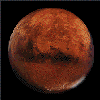|
~
Mars |
||
-- Mars------ The forth closest to the sun Mars is the fourth closest planet to the Sun and the second closest planet to Earth; only Venus is closer to our planet. Mars is the third smallest planet; only Mercury and Pluto are smaller. In fact, Mars' diameter is only about half that of the Earth and it's mass is only about one-tenth that of our planet. The strength of Mars' gravitational pull is only 38 percent that of Earth. The two moons of Mars are not round but are shaped like potatoes. Phobos and Deimos are their names. If you want to examine Mars' surface features, all you need is a telescope; it is the only planet whose surface features can be seen from Earth. When you look at the planet, you'll see why it's called the "Red Planet." Mars' surface is heavily oxidized, or rusted, which gives it a reddish color. In fact, Mars was named after the bloody-red Roman god of war. Running water shaped the planet's surface. Mars' Valles Marineris canyon system, which runs for over 2,500 miles and has three to six miles of relief between the tops and bottoms of its plateaus, is the largest and deepest known canyon system in our solar system. The canyon system is four times as deep as our Grand Canyon. Olympus Mons, the planet's tallest volcano, is three times higher than Mount Everest, Earth's highest mountain. The planet's surface also has many craters from meteorite impacts. Like Earth, running water shaped Mars' surface. Scientists now believe that they may have found evidence of liquid water on Mars at present. This is very exciting because water is necessary for life. Mars is a very cold planet. It is colder than the Earth because it is farther from the Sun. Because of its distance from the sun, one year on Mars is equal to 687 Earth days. Mars also has "ice" caps. However, they are really made of frozen carbon dioxide and frozen water. Each year, as one of the planet's polar ice caps grows the other one shrinks - then the reverse happens. Mars's atmosphere is very thin; it's only about one-hundredth as thick as the Earth's atmosphere. Carbon dioxide makes up about 95 percent of the planet's atmosphere. The planet's sky looks pink because of the red dust blown by the wind. In fact, every Martian year the planet has a global dust storm with the force of a hurricane. The storm usually occurs at the start of the Southern Hemisphere's spring season. There is also a wave of darkening that seems to run from the equator to each hemisphere's pole during its spring. Although there are many differences between Mars and Earth, there are some similarities. Both planets are tilted on their rotational axes. Because of this, both planets experience seasonal changes in climate. In the past, temperature and atmospheric conditions on Mars were more probably more like those conditions on our planet. It was probably warmer and the atmospheric pressure was probably higher. Mars was probably even warm enough to support running water. Today, however, Mars' seasons last two times longer than Earth's and are more extreme. One day on Mars lasts about 24 hours and 37 minutes. Scientists have always been intrigued by the possibility that life may have existed on Mars. Percival Lowell, an American astronomer, saw what he thought were canals on Mars that he speculated might have been built to carry drinking water for Martians. Since that time, however, astronomers have learned that there aren't any canals on the planet. Several unmanned spacecraft have visited Mars. The Mariner 4 gave us our first views of the planet in 1964. In 1969, Mariners 6 and 7 performed flyby missions. The first accurate, full-planet map of Mars was made in 1971 by the Mariner 9 orbiter. In 1976, the U.S. Viking 1 and 2 orbiters sent spacecraft to Mars' surface to look for evidence of life. This was the first landing on Mars, but the spacecraft found no evidence of life. In 1996, possible evidence of life on Mars was discovered in a meteorite on Earth. The evidence is still being disputed, however. In 1997, the Mars Pathfinder was sent to examine Mars' surface.
|
||

